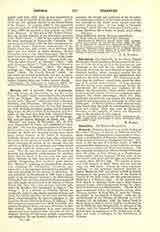

Diaconicum (Gr. diakonikon), in the Greek Church the liturgical book specifying the functions of the deacon; it is also the name given to the Orationes pro pace (diakonika) to be said by him before the people.
Primarily, however, the word denoted an annex to the Christian basilica, where necessary supplies for the service of the altar were kept and preparations were made for the Holy Sacrifice. The diaconicum is distinct from the prothesis, a small room where the offerings of the people were received. In large churches the diaconicum majus comprised several rooms: the salutatorium, for reception and audiences of the bishop; the thesaurarium, where sacred vessels and books were kept; and the diaconicum properly so called. Possibly the Greek pastophorion, where the Holy Eucharist was reserved, was simply the diaconicum. Prothesis and diaconicum are ordinarily on either side of the apse. In Syrian churches, where they are regularly found, they are built on a rectangular plan and have two stories. They also exist in Byzantine churches, in the basilicas of Africa and frequently even in the churches of other regions.
R. MAERE

